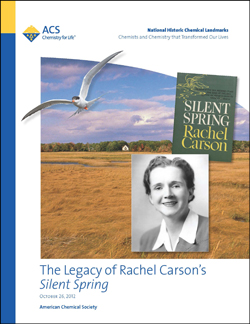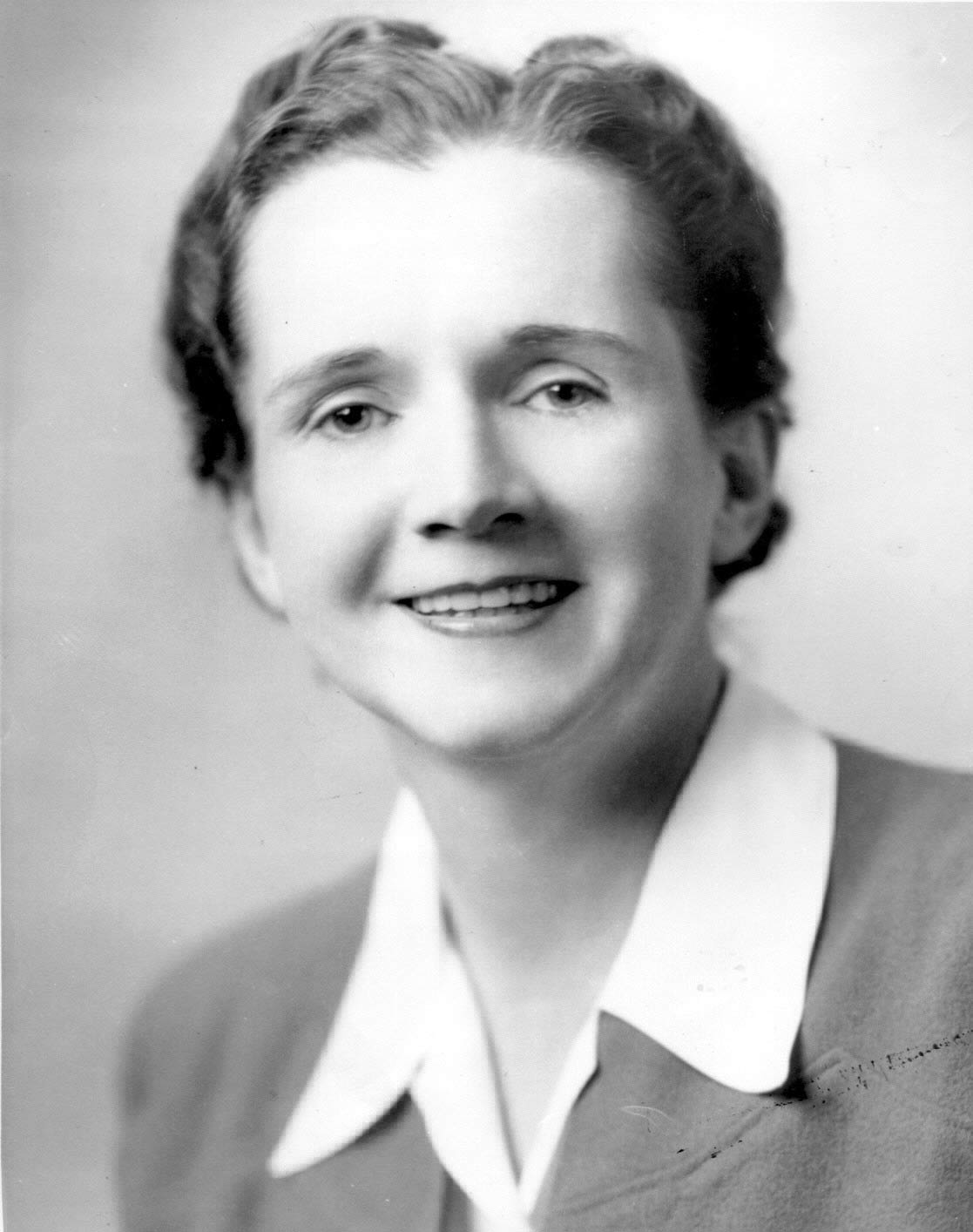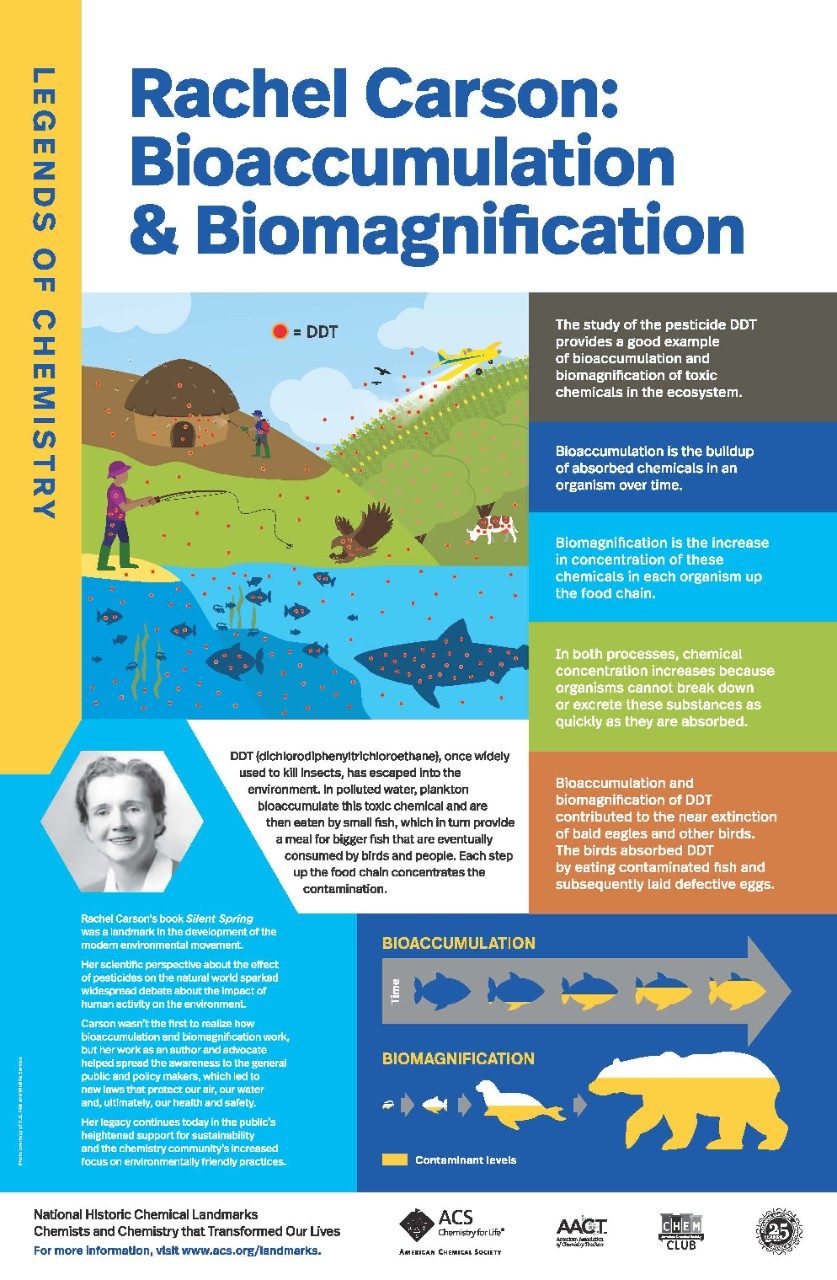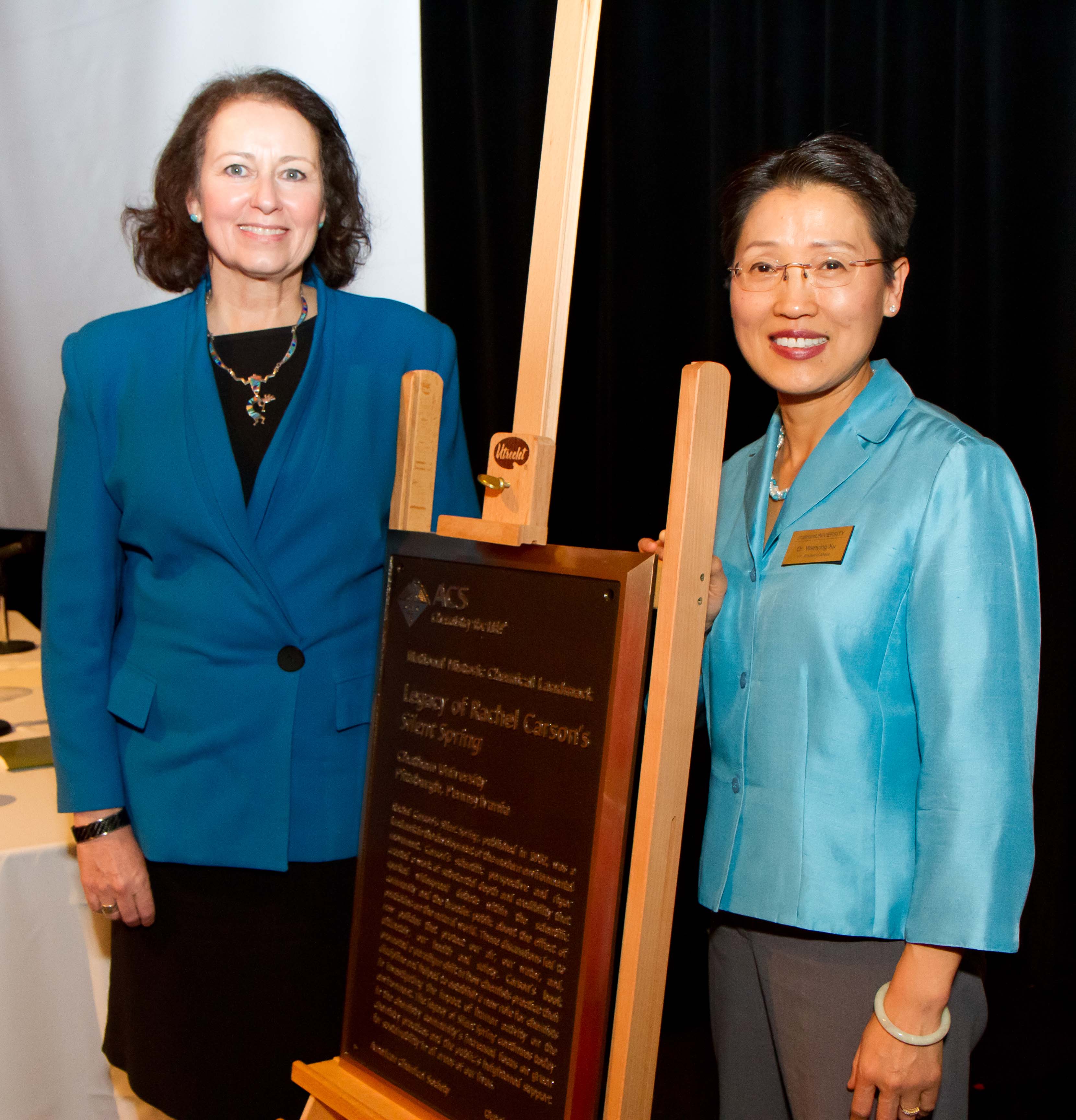Legacy of Rachel Carson's Silent Spring
Designated October 26, 2012, at Chatham University in Pittsburgh, Pennsylvania.
In Spanish: El legado de Primavera silenciosa de Rachel Carson
Rachel Carson’s Silent Spring, published in 1962, was a landmark in the development of the modern environmental movement. Carson’s scientific perspective and rigor created a work of substantial depth and credibility that sparked widespread debate within the scientific community and the broader public about the effect of pesticides on the natural world. These discussions led to new policies that protect our air, our water, and, ultimately, our health and safety. Carson’s book promoted a paradigm shift in how chemists practice their discipline and helped to establish a new role for chemists in investigating the impact of human activity on the environment. The legacy of Silent Spring continues today in the chemistry community’s increased focus on green chemistry practices and the public’s heightened support for sustainability in all areas of our lives.
Contents
Science and Progress after WWII
If a civilization is judged by the wisdom of its ways, the 21st century owes considerable gratitude to one woman, Rachel Carson, whose book Silent Spring, published in 1962, revolutionized how people understand their relationship with the natural environment. Specifically, Silent Spring explained how indiscriminate application of agricultural chemicals, pesticides, and other modern chemicals polluted our streams, damaged bird and animal populations, and caused severe medical problems for humans. But her treatise did much more. Silent Spring introduced a paradigm shift in how chemists practice their discipline and how society at large relates to science.
To understand how radically her book changed the modern mindset, we have to go back to the time between World War II and the late 1950s when Carson first decided to write Silent Spring. New technologies flourished during the war as biologists, chemists, physicists, andothers were enlisted to aid the military. After the war, science and industry translated these developments and others into commercial products aimed at improving the quality of life for civilians.
DDT (1,1,1-trichloro-2,2-di(4-chlorophenyl)ethane, also known as dichloro-diphenyl-trichloroethane) is one such example. A potent insecticide, DDT was effective at preventing the spread of typhoid, malaria, and other diseases transmitted by insects, and it saved countless lives during the war. After the war, the U.S. Department of Agriculture and corporations promoted DDT and other powerful chemicals to increase domestic productivity and combat a variety of ills. DDT’s widespread use is reflected by the range of products in which it was sold, from large-scale aerial sprays to insecticidal paint and wallpaper. U.S. production of DDT leaped from 4,366 tons in 1944 to a peak of 81,154 tons in 1963.
Carson, who was employed with the U.S. Fish and Wildlife Service (FWS) from 1936 until 1952 as a field scientist and writer, was acutely aware of the policies and practices of the day. In her view, government leaders and industry were eager to create sweeping change, but advanced new technologies without knowing the full implications of their decisions. Carson was moved by the relationship between humans and the natural world and worried about the effects of scientific interventions on the environment.

It is not my contention that chemical insecticides must never be used. I do contend that we have put poisonous and biologically potent chemicals indiscriminately into the hands of persons largely or wholly ignorant of their potentials for harm. ...
“...we have allowed these chemicals to be used with little or no advance investigation of their effect on soil, water, wildlife, and man himself. Future generations are unlikely to condone our lack of prudent concern for the integrity of the natural world that supports all life.”
— Rachel Carson, Silent Spring, 1962
Rachel Carson: Master of Two Worlds
Rachel Carson may have been one of the few people capable of writing with the scientific thoroughness her subject required and the sincerity and engaging writing style that riveted a nation’s attention. Carson was born in 1907 in Springdale, Pa., a rural river town outside of Pittsburgh. Carson’s mother Maria encouraged her daughter to write, and by age 11, Carson was winning writing competitions. In 1925, she entered the Pennsylvania College for Women (now Chatham University) to pursue a writing career, but after classes in biology Carson changed majors, graduating with honors in 1929. She completed a master’s degree in zoology from Johns Hopkins University in 1932.
Carson’s fascination and skill with science coupled with her love of and desire to protect natural areas inspired the rest of her life and is revealed in the work she embraced, both for FWS and personally.
In 1951, The Sea Around Us elevated Carson to fame and cemented her credentials as a successful interpreter of science for the public. The book was a bestseller at the outset, selling 250,000 copies in its first year of publication, and the following year, Carson was awarded the National Book Award for nonfiction for the work. In her acceptance speech she outlined her beliefs about the public’s interest in science:
“Many people have commented with surprise on the fact that a work of science should have a large popular sale. But this notion that ‘science’ is something that belongs in a separate compartment of its own, apart from everyday life, is one that I should like to challenge. ...Science is part of the reality of living; it is the what, the how, and the why of everything in our experience. It is impossible to understand man without understanding his environment and the forces that have molded him physically and mentally.”
Silent Spring: A Change in Perspective
In Silent Spring, Carson assembled information on chemicals used in aerial sprayings, in industrial settings, and on food to characterize the impacts of these agents in ecological terms rather than simply portraying the effectiveness of the chemical solutions. Carson built her case on science. She did extensive research, citing dozens of scientific reports, conducting interviews with leading experts, and reviewing materials across disciplines.
Silent Spring seeded important new ideas in the public mind: That spraying chemicals to control insect populations can also kill birds that feed on dead or dying insects. That chemicals travel not only through the environment, but through food chains. That chemicals that don’t outright kill can accumulate in fat tissues causing medical problems later on, and that chemicals can be transferred generationally from mothers to their young. These were ideas new to the public consciousness, and paramount among them was the notion that life is much more interconnected and interdependent than people assumed or understood. Yet, Carson called not for an outright ban on agricultural chemicals but for caution, further study, and the development of biological alternatives.
When Silent Spring was released in the fall of 1962, it was met with enormous public interest and substantial criticism. Many government leaders, including President John F. Kennedy and his Secretary of the Interior, Stewart L. Udall, took Carson seriously. Those who stood to be professionally undermined by the policies her ideas would soon help to shape criticized her vehemently. Dr. William J. Darby authored a review of Silent Spring—titled “Silence, Miss Carson”—in the Oct. 1, 1962, issue of Chemical & Engineering News, published by the American Chemical Society. Darby criticized Carson for not adopting the views of “responsible, broadly knowledgeable scientists” and recommended that “in view of her scientific qualifications in contrast to those of our distinguished scientific leaders and statesmen, this book should be ignored.”
Rachel Carson's Legacy
But Carson’s book was not ignored. Her research and ideas became central testimony at two congressional hearings, and a Presidential Science Advisory Committee report on pesticides in 1963 affirmed Carson’s call for limits on pesticide use and further research into their health hazards. Carson and her book Silent Spring are frequently cited as the catalysts that inspired the environmental movement that began in the 1960s and which gained national and international momentum by the 1970s. The years following the controversy over Silent Spring saw the establishment of the U.S. Environmental Protection Agency and the passing of numerous laws protecting the environment and human health, including a ban on domestic use of DDT in 1972 due to its widespread overuse and harmful impact on the environment.
Since the publication of Silent Spring, the chemistry discipline has grown to include green chemistry—the design, development, and implementation of chemical products and processes that reduce or eliminate the use or generation of substances hazardous to human health and the environment—and a new role for chemists in investigating the impact of human activity on the environment. Scientists, policy makers, and the public now recognize and weigh trade-offs of new technologies. Several generations have grown up embracing Carson’s ideals of ecological awareness, environmental protection, and conservation.
A more telling measure of how attitudes have changed is reflected in a letter penned by Rudy M. Baum, Editor-in-Chief of Chemical & Engineering News, published in the June 4, 2007, edition:
“At a time when humans largely believed themselves to be apart from nature and destined to control it, Carson argued passionately that nature is, in fact, a network of interconnections and interdependencies and that humans are a part of that network and threaten its cohesion at their own peril. ...What is mainstream today was heretical in 1962, and I think this part of Carson’s argument is what earned her such enmity when Silent Spring was published.”
Carson, who died in 1964, inspired a new paradigm of thinking—where humanity is not the center of life on earth, but part of nature. The legacy of Silent Spring continues today in the scientific community’s increased focus on environmentally friendly practices and the public’s heightened support for sustainability in all areas of our lives.
Additional Resources
Lesson Plan
Further Reading
- Rachel Carson Collection (Chatham University)
- Paul H. Müller, discoverer of DDT as insecticide, (NobelPrize.org)
- Rachel Carson: A Conservation Legacy (U.S. Fish & Wildlife Service)
Landmark Designation and Acknowledgments
Landmark Designation
The American Chemical Society designated the legacy of Rachel Carson’s Silent Spring as a National Historic Chemical Landmark at Chatham University in Pittsburgh, Pennsylvania, on October 26, 2012. The text of the plaque commemorating the development reads
Rachel Carson’s Silent Spring, published in 1962, was a landmark in the development of the modern environmental movement. Carson’s scientific perspective and rigor created a work of substantial depth and credibility that sparked widespread debate within the scientific community and the broader public about the effect of pesticides on the natural world. These discussions led to new policies that protect our air, our water, and, ultimately, our health and safety. Carson’s book promoted a paradigm shift in how chemists practice their discipline and helped to establish a new role for chemists in investigating the impact of human activity on the environment. The legacy of Silent Spring continues today in the chemistry community’s increased focus on green chemistry practices and the public’s heightened support for sustainability in all areas of our lives.
Acknowledgments
Adapted for the internet from “The Legacy of Rachel Carson’s Silent Spring,” produced by the National Historic Chemical Landmarks program of the American Chemical Society in 2012.




